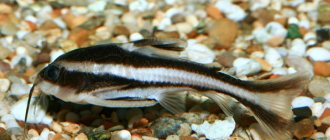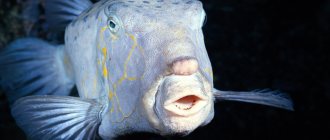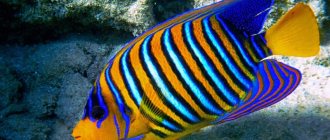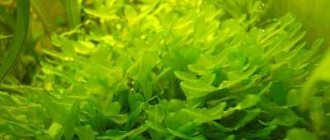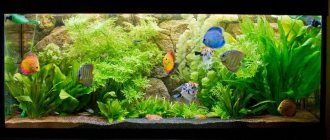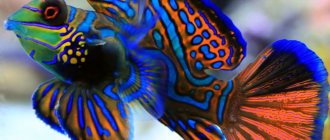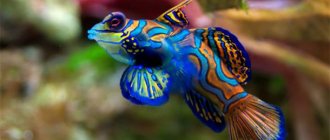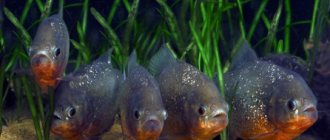10/11/2019Pisces0
The Karpov family's pet is distinguished by its easy-going disposition and unique beauty. There are many varieties of Labeo known, but the most common is two-colored; it is listed in the Red Book as endangered. The population decline is caused by human intervention, as the construction of dams has destroyed the fish's natural habitats.
- 1 Description and natural habitat
- 2 Mr. Tail recommends: variety of species
- 3 Basics of aquarium keeping
- 4 Compatibility
- 5 Feeding
- 6 Breeding
- 7 Diseases and prevention
Description
The modest size of the fish does not stop it from attacking larger fish. Cichlazoma is suitable for beginners due to its strong immunity and easy breeding.
Appearance
The body is oval with pointed fins, reaches 13–15 cm in length. The color is gray-blue with 8–9 black vertical stripes extending onto the fins. The fins of the cichlid are translucent and pointed. Zebra cichlisoma has large eyes and lips.
Behavior
Territorial nature makes it difficult to choose neighbors. The male may become overly aggressive during spawning. And also black stripes are good parents.
Lifespan
On average, cichlazomas live 8–10 years, in good conditions - 15 years.
Kinds
Selection has given rise to some subspecies of black stripes. Differences between individuals can be seen in the comparative table of subspecies.
| A variety of cichlazoma | Color | Immunity |
| Black striped | Striped bluish black | Strong |
| Flamingo | From white-pink to crimson | Normal |
| Albino | White | Weak |
| Disc shape | All species colors | Normal |
The albino form is a product of mutation, the discoid form is the product of breeders. There are many questions surrounding the flamingo species: no one knows exactly how this species of cichlid appeared. Often the description of flamingo cichlizoma is accompanied by the statement that it is an albino form of the black stripe. The content requirements are slightly different for the three different forms.
Mr. Tail recommends: variety of species
Currently, there are more than 120 genera in the Labeo subfamily, and many striking breeding forms have been developed.
Here are some colorful varieties.
| Name | Size in cm | Description |
| Bicolor (two-color) | 12 | Black velvet body with a bright red caudal fin. The homeland of the bicolor species is in Thailand in the Chao Phraya River, where Labeo was first discovered. Poor ecology and excessive human intervention led to complete extinction; a little later, a small population was found in a tributary of the Mekong; it is carefully protected by ichthyologists. Shallow, clean rivers and streams serve as a home for the fish; during the rainy season, when the rivers overflow, they go out into fields and forests where they spawn. It was the lack of opportunity to migrate and reproduce that led to the death of most of the species. Externally, the pet looks like a shark, a cylindrical, slightly compressed body, a mouth located at the bottom with a pair of funny mustaches, and a high, pointed dorsal fin. All these characteristics are complemented by velvety black or gray skin color and scarlet tail and pectoral fins. Once you see a fish, it is impossible to forget it. Labeos are bred in captivity and are loved by many aquarists for their gentle disposition and interesting behavior. |
| Albino | 10 | These are attractive individuals with a white body, red eyes and fins. |
| Harlequin (Congolese) | 16 | At a young age, the body color is golden brown with dark spots, reaching maturity it becomes gray. |
| Green (rainbow) | 12 | Dark green body, belly with a yellow tint, red-finned appearance. There is a dark spot at the base of the tail. |
| Silver | 10 | The beautiful silver color has clearly defined scales. It seems to be painted on the body of the fish. The fins are crystal clear. |
| Leopard | Rare view. Dark spots are randomly located on the gray body, forming blurry stripes. | |
| Black | 60 | An omnivorous giant of rich black color. The eyes are slightly bulging. |
Content
The fish is unpretentious compared to other cichlids. Provide your cichlids with high-quality equipment and a large aquarium.
Aquarium
The minimum volume of an aquarium for a couple of individuals starts from 100 liters. A small group of black stripes will require a 300 liter container.
Water parameters
Zebra fish are suitable for water with the following parameters:
- acidity 6–8;
- hardness 2–20 dGh;
- water temperature 24–28 degrees.
General information
Black-striped cichlasoma, also called Zebra cichlasoma, was brought from Central America more than 100 years ago. This is the very first fish from the aquarium cichlid species, which began to be bred at home. The centuries-old history of breeding has not in any way diminished the interest of aquarists in its maintenance.
Black-striped cichlasoma is a territorial fish. This point should be taken into account when moving neighbors to her. Cases have been recorded when cichlazoma, during spawning, attacked fish that were much larger in size than itself. But this is only during the spawning period. With the right selection of neighbors, such clashes should not occur.
Black-striped cichlazoma is one of the smallest representatives of its group
Feeding
Have a varied diet. Do not overuse dry food. The diet of black stripes must include frozen or live food. Plant nutrition is required. Omnivorous cichlazomas feed on:
- tubifex;
- bloodworm;
- shrimp;
- mussels;
- dry food;
- minced meat;
- artemia;
- cabbage and lettuce leaves;
- duckweed;
- zucchini.
Blackstripes are prone to overeating, so feed small portions in the morning and evening. The food should be eaten within 3-5 minutes. Remove excess with a siphon or net.
Habitat
In 1867, the first individuals of black-striped cichlid were described. In 1927, the fish spread throughout Europe. The homeland of this exotic underwater resident is Central America. In the 21st century it was discovered in the southern states of the USA.
Black-striped cichlasoma prefers to swim in small or large rivers with fast currents, preferably with a rocky bottom. Such natural conditions allow the fish to find shelter from enemies. Open spaces are not for cichlids. The diet of natural species includes larvae, worms, insects, and plants. In nature, the average life expectancy is 10 years.
Compatibility
The black-striped cichlazoma is completely incompatible with other small fish and large predators. Bad neighbors for striped cichlids:
- neons;
- cockerels;
- rasboras;
- guppy;
- zebrafish;
- piranha;
- discus;
- angelfish;
- swordtails.
It is optimal to keep black-striped cichlids in a species aquarium. Compatible with cichlids from the same biotope and similar sizes, as well as calm, slow-moving fish:
- corridors;
- ancistrus;
- parrot fish;
- apistograms.
Labyrinthine
Gourami grumbling
This is one of the most common types of gourami. A very beautiful fish that has a bright pearl or green-bluish color. In aquariums they grow up to 5 centimeters.
Marbled gourami
The name gourami speaks for itself - the color of the fish is marbled, white and blue. Fish can readily breed in an aquarium, and the male will build a nest of foam, where the offspring will be raised.
Pearl gourami
A very popular fish among aquarists. As you can see in the photo, gourami are characterized by two long whiskers on the stomach, as well as a black stripe along the body. It is a classic representative of labyrinth fish.
Lyalius
Looking at the photo, I just want to call her a fat gourami :). In fact, the fish is very cute and beautiful. The color can be either silver-blue or red-raspberry. Lalius are shy, so we do not recommend disturbing them again.
Macropod
A good fish that does not like encroachment on its territory. Although she is beautiful, she requires proper treatment. It is better not to plant them with their own kind; there are enough females and males of this species in the aquarium; they can get along with neons, guppies and other small species.
Cockerels
The so-called fighting fish. Males can be extremely aggressive towards other males, and sometimes towards females, if they lack space. Bettas can be kept even in the smallest aquariums, as they are not sensitive to volume.
Reproduction
Black-striped cichlids are easy to breed. The fish form stable pairs, carefully guarding their offspring.
Sex differences
Sexual dimorphism in black-striped cichlasomas is clearly pronounced. There are several differences between a male and a female:
- the male reaches 15 cm, the female – 10 cm;
- The color of black-striped males is less bright than that of females;
- males have a fatty bump on the forehead;
- there are spots resembling eggs;
- pointed fins.
Spawning
Sexual maturity occurs at 8–10 months. Cichlazomas reproduce all year round in a common tank or in a spawning area. You can save the offspring in a common aquarium by making a plexiglass partition. The fenced area should occupy a third to a quarter of the space and separate producers from neighbors.
Stimulate the spawning of black stripes with frequent water changes and a gradual increase in temperature to 28–29 degrees. When zebras are ready to breed, they set up a nesting site. Cichlazomas dig holes in the ground or use decorative elements to place eggs. The clutch contains 300–400 eggs, which the female fans with her fins and the male fiercely defends. After 2–3 days, the fry appear and soon begin to feed and swim independently.
Caring for fry
The fry stay in a school close to their parents. At night, the female sends the young to the “nest” to sleep, where she covers them with her body. Do not separate the offspring from the parents too early, this will lead to stress and aggression in the parents. Starter feed:
- Cyclops;
- Artemia nauplii;
- daphnia;
- chopped food for adult fish;
- branded food for fry.
View this post on Instagram
We have an addition! Who wants free fry? #newperedelkino #remadekinoblizhnee #Cichlids #cichlids #black-striped cichlid #fish #free #kind hands
A post shared by Marusya (@fedotikmasha) on Sep 25, 2021 at 11:39pm PDT
After three weeks, the fry grow up and consume uncrushed cichlas food for blackstripes.
What is the danger
The lionfish poses a danger to marine life and to humans. The fins contain spines that contain poison. When she senses danger, she begins to quickly spread her poisonous fins. After which it actively attacks and tries to stab the enemy. If suddenly while swimming or bathing in the sea or ocean you come across a zebra fish on your way, you should not touch it with your hands. Even one injection carries a danger to human health. And if she injects several times in a row, the negative consequences increase.
Severe pain appears at the site where the injection was made. It is accompanied by numbness, swelling, the affected area looks reddened, and hyperemia occurs. If a person suffers from diseases of the cardiovascular system, there is a danger of deterioration in heart function, the appearance of arrhythmia, and sudden jumps in blood pressure. Nausea, convulsions, shortness of breath, shock, and loss of consciousness may also occur. It is important to be careful, do not swim close to reefs and algae, and do not touch them with your hands.
If the lion fish senses danger, it may attack. But she will not attack first if no one claims her territory. Injections in people most often occur accidentally or are the result of careless human behavior.
Diseases
- Ichthyophthiriasis (semolina). For treatment, increase the temperature to 30–32 degrees; if this does not help, use special-purpose drugs or a solution of quinine hydrochloride. For every liter of liquid, add 0.25 g of the drug.
- Ammonia poisoning. Maintain your aquarium promptly and regularly to prevent poisoning of water inhabitants.
- Hypoxia (oxygen starvation). Occurs in an overcrowded vessel and with poor quality aeration. A lack of oxygen is indicated by the predominance of fish in the upper layers of water and frequent movements of the gills and mouth.
- Tuberculosis. The cause of the disease is poor fluid quality. Incurable, leads to the death of fish.
- Cotton disease. Occurs when immunity decreases, formations resembling cotton wool appear on the body.
Diseases
By nature, Platidoras is a very hardy fish with high immunity. But, unfortunately, in closed water conditions there are frequent cases of viral diseases, parasites and the development of fungal infections .
The most common diseases in striped catfish:
- ichthyophthyriosis;
- fungal diseases.
The infected fish must be isolated from the rest before treatment begins.
Reviews
Aquarists pay attention to the varied character and behavior of black-striped cichlases in different bodies of water. It is noted that the color changes depending on the lighting and the well-being of the fish. According to some articles, cichlazomas carry eggs in their mouths during spawning, but aquarists have not noticed this with their pets.
Origin
Amphiprion ocellaris was described by Cuvier in 1830. Found in the Indo-western Pacific and eastern Indian Ocean. Near Thailand, Malaysia, Australia, in Singapore, through Indonesia, the Philippines, from the north in Taiwan and the Ryukyu Island. This species is not listed in the Red Book.
Clownfish are found in calm, shallow lagoons, coastal reefs and murky bays. They can also live on outer reef surfaces and reef flats, but always in shallow water between 1 and 15 meters. They feed on zoobenthos, including crustaceans, amphipods, small shrimp and serrated shrimp, as well as algae, detritus and invertebrate plankton. One large anemone will fit an adult pair or more non-spawning fish of the same species.
Adults live in coral reefs with a variety of sea anemones, including Heteractis magnifica, Stichodactyla gigantea and the Mertens carpet anemone (Stichodactyla mertensii), which protect them from predators with their stinging tentacles. These fish are highly dependent on their sea anemone host and do not risk swimming more than 30 cm from this protective home. It has been suggested that clownfish use the bright orange appearance as a “warning” color to warn predators of the potential danger of being stung if they swim too close to their sea anemone.
Photo
Adviсe
- Place the aquarium with black-striped cichlids on a special stand. The volumetric tank is quite heavy to break a cabinet that is not strong enough.
- Gradually adapt the newly acquired black stripes to the conditions of your home pond. Place a bag of fish in a tank filled with water and let the temperatures equalize. After half an hour, gradually pour aquarium water into the bag in small portions.
- Make sure the plants have enough light. The flora, lacking light, dims and withers, growth is drawn in the direction of the light source. Replace the lamp with a more powerful one or install an additional light source.
- Do not buy food in bulk. Always look at the expiration date and read reviews about the manufacturers.
- Do not separate pairs of blackstripes or destroy their spawning areas. Cichlazomas do not form stable pairs throughout their lives and may refuse to spawn in the future with another partner. The spawning site often remains unchanged.
Black-striped cichlasoma is an aquarium inhabitant that remembers its breadwinner. Some aquarists tame the cichlid so that the fish allows itself to be petted and fed by hand. A cichlid can also bite if it doesn't like something.
Previous
FishRarely seen labyrinth fish, Pineapple
Next
Fish10 species of cichlids Aulonocara orchid
Varieties of singing catfish
There are several varieties of platidoras. Aquarists identify four popular species of singing catfish.
Types of Platydoras:
- Striped. This is one of the most popular catfish-like fish in aquariums. Striped catfish are very beautiful, with wide stripes along the entire body - white and black. It is found naturally throughout South America.
- Striped brachylesis. Found in the rivers of Brazil. The species is distinguished from other platidoras by bright yellow lines stretching across the entire body.
- Raphael's unassuming platidoras. These are unpretentious catfish that are widespread in natural reservoirs of South America. And they are the ones most often sold in pet stores.
- Platydoras Hancock. In nature, it is found not only in rivers, but also in swamps, ponds, and lakes. These catfish have a brown line running along their body, along which representatives of this species can be easily recognized.
Singing catfish are successfully raised on special fish farms, so aquarists can purchase these aquarium fish in pet stores without any problems.
